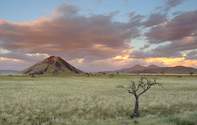
Years after the dinosaurs roamed the earth, the first grass species came into existence in the Miocene and Pliocene epochs, and vast grasslands began to replace trees in parts of the world. Today, almost half of Africa is covered by grasslands.
Grasslands in tropical regions are known as savannas, while elsewhere in the world they are known as temperate grasslands. Temperate grasslands can be divided into prairies and steppes. The South African veld is also a temperate grassland.
Grasslands in Australia are known as rangelands, while in South America they are called pampas, cerrados or llanos. Climate is an important deciding factor in the formation of a savanna, where between 50 and 130cm of rain must fall in a distinct seasonal pattern. Year-round rainfall produces tropical forests, whereas a dry season allows fires to burn and maintain the ecosystem as a grassland. Temperate grasslands also have distinct seasonal rainfall, but generally survive on less rain than savannas.
Savannas can also be created by shallow soils and the clearing of forested areas by both man and elephants. Many animal species find homes in savannas, and the strong grazing pressure often causes one or a few grass species to thrive in different areas. Deciduous trees and shrubs may also grow in savannas, and in some places trees are only found on the richer soils of termite mounds. Grasses survive high grazing pressure because their growing points are close to the soil, and are not usually removed by grazing.
Grasslands are often endangered ecosystems, because many natural grasslands are often turned to agricultural use - either to graze (and sometimes overgraze) domestic livestock, or are ploughed up to grow crops. Natural grasslands are often flat, and their lack of trees makes them an easy target for ploughing.
Illinois, known as the "Prairie State" in the United States, has lost nearly all its natural prairie grassland to agriculture - it is estimated that only 0.01 percent of natural prairie grass is left. This occurs in graveyards, along railway lines, and hillsides that cannot be easily ploughed.

 The central grasslands have the highest lion population in Kruger. That's because of the availability of prey. The nutritious grasses suppor...
The central grasslands have the highest lion population in Kruger. That's because of the availability of prey. The nutritious grasses suppor...